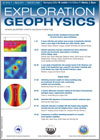
Exploration Geophysics
Volume 48 Number 1 2017
RESEARCH FRONT: Geophysical Surveys after the Great Eastern Japan Earthquake
EG16099S-wave reflection and surface wave surveys in liquefaction affected areas: a case study of the Hinode area, Itako, Ibaraki, Japan
We performed surface wave and S-wave reflection surveys to investigate the Hinode area of Itako, Ibaraki, Japan. This area suffered serious liquefaction damage during the Great Eastern Japan Earthquake of 2011. Using subsurface boundaries imaged by the reflection surveys and the Vs structures obtained by surface wave analyses, we delineated the layer in which liquefaction occurred.
EG16113Shallow subsurface structure estimated from dense aftershock records and microtremor observations in Furukawa district, Miyagi, Japan
Severe residential damage in the Furukawa district, Miyagi, Japan, occurred during the Great Eastern Japan Earthquake of 2011. We model the shallow subsurface structure based on aftershock records from a dense seismometer network and results of microtremor observations. Site amplifications estimated from the model explain the damage distribution well.
EG16137A case study of liquefaction risk analysis based on the thickness and depth of the liquefaction layer using CPT and electric resistivity data in the Hinode area, Itako City, Ibaraki Prefecture, Japan
The Hinode area of Itako City in Ibaraki Prefecture, Japan, suffered severe liquefaction damage in the Great Eastern Japan Earthquake in 2011. The National Institute of Advanced Industrial Science and Technology (AIST) has carried out numerous investigations in the area. We have conducted risk analysis using cone penetration testing and electric resistivity data. The distribution of the risk estimated from both data sets is in agreement with the distribution of actual damage.
EG15013Initialising reservoir models for history matching using pre-production 3D seismic data: constraining methods and uncertainties
A fundamental step in reservoir characterisation and modelling is the preconditioning of the initial reservoir model to honour both the geological knowledge and seismic data. In this paper, we analyse the issues that have significant impact on the (mis)match of the reservoir model with well logs and inverted seismic data.
EG15006A seismic diffraction extraction method for the study of discontinuous geologies using a regularisation algorithm
By considering two constraints from the Sobolev penalty function and the difference operator, we have developed an optimised regularisation model for extracting seismic diffractions. An efficient iterative method based on projection onto a convex set has been developed to solve the minimisation problem. The proposed method has high-resolution capability for detecting small-scale discontinuities.
EG15050Azimuthal AVO signatures of fractured poroelastic sandstone layers
Frequency-dependent seismic responses from a fractured sandstone layer show complex azimuthal variations due to anisotropic propagation and attenuation of transmission waves associated with fluid flow. It would be practical to investigate wavetrains reflected from the fractured layers that are regarded as integrated units.
EG14126Automatic detection of multiple UXO-like targets using magnetic anomaly inversion and self-adaptive fuzzy c-means clustering
A method for automatically detecting UXO-like targets based on magnetic anomaly inversion and self-adaptive fuzzy c-means clustering is proposed. Magnetic anomaly inversion methods are used to estimate the initial locations of targets. The self-adaptive fuzzy c-means clustering algorithm is then used to cluster these initial locations, giving the number and locations of magnetic targets.
EG15068Comparison of artificial absorbing boundaries for acoustic wave equation modelling
We provide a thorough review of all typical absorbing boundary conditions and derive their equations in a uniform mathematical form. We examine their performance via numerical experiments and qualitatively show their advantages and disadvantages. Finally, we provide some suggestions on choosing different boundary conditions for practical applications.
EG15068 Abstract | EG15068 Full Text | EG15068PDF (1.7 MB) Open Access Article

